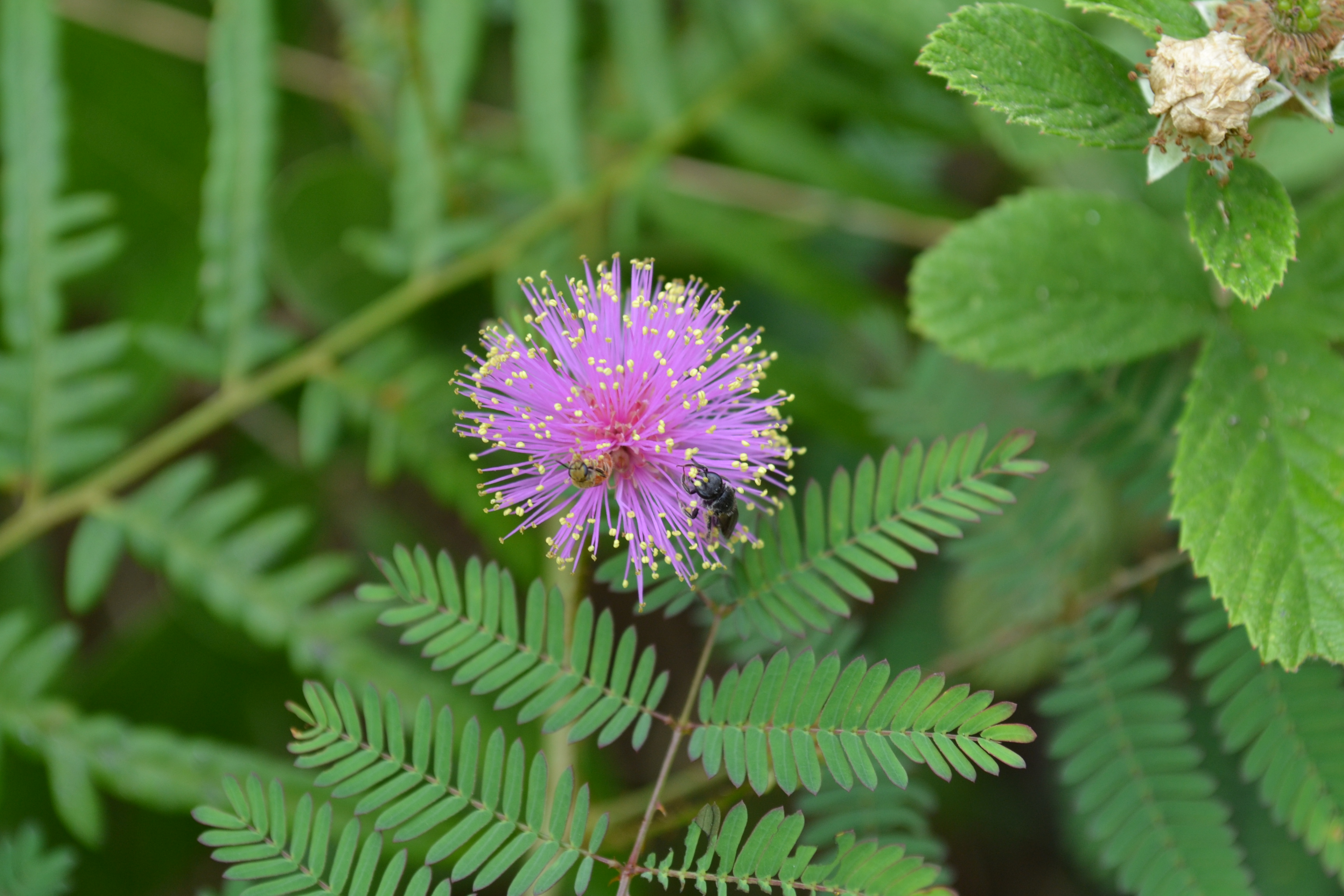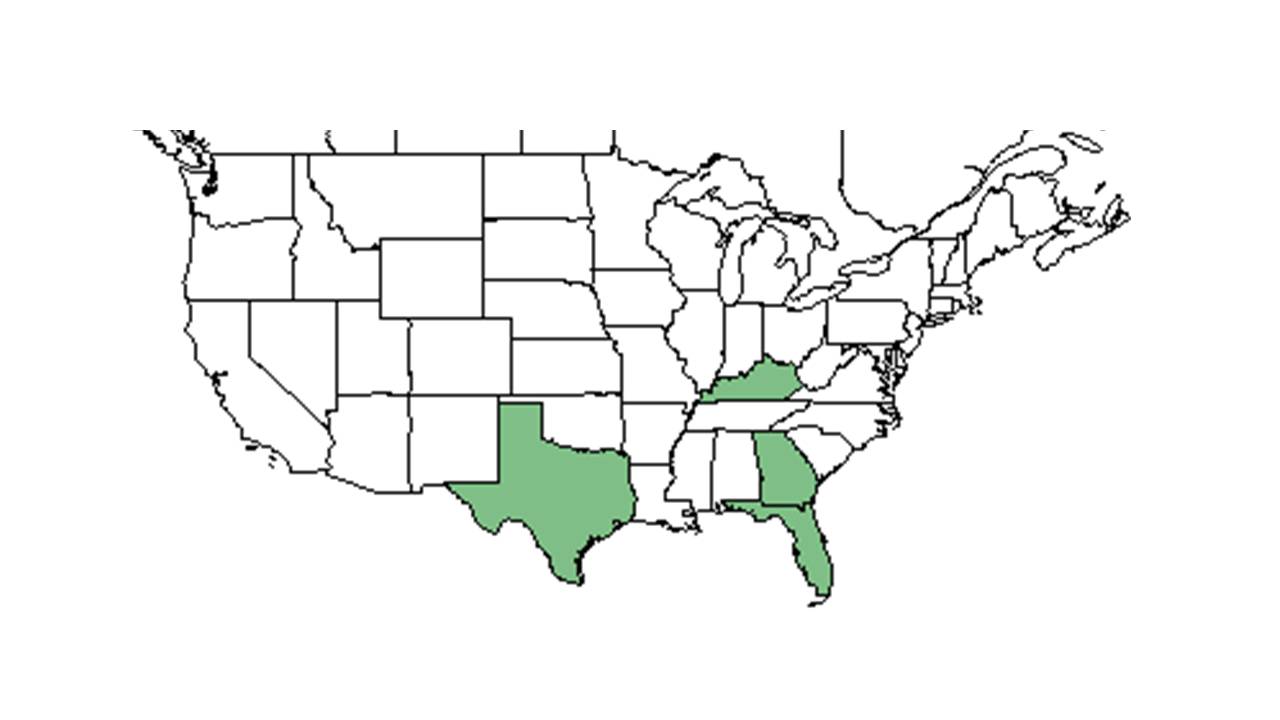Difference between revisions of "Mimosa quadrivalvis"
(Created page with "{{italic title}} <!-- Get the taxonomy information from the NRCS Plants database --> {{taxobox | name = Mimosa quadrivalvis | image = Mimosa quadrivalvis MMS.jpg | image_capti...") |
|||
| Line 21: | Line 21: | ||
==Distribution== | ==Distribution== | ||
==Ecology== | ==Ecology== | ||
| + | In a study comparing N2 fixation potential in nine legume species occurring in longleaf pine-wiregrass ecosystems, M. quadrivalvis showed clear superiority in developing a comparatively large nodule mass to support high N2 fixation activity (Cathey et al. 2010). Aboveground N concentration was also greatest for M. quadrivalis (Cathey et al. 2010). Finally, N2 fixation potential for M. quadrivalvis does not differ between shaded and unshaded environments (Cathey et al. 2010). The high potential for N2 fixation makes M. quadrivalvis a candidate species for contributing to the N economy in the restoration of longleaf pine ecosystems (Cathey et al. 2010). | ||
===Habitat=== <!--Natural communities, human disturbed habitats, topography, hydrology, soils, light, fire regime requirements for removal of competition, etc.--> | ===Habitat=== <!--Natural communities, human disturbed habitats, topography, hydrology, soils, light, fire regime requirements for removal of competition, etc.--> | ||
| + | Commonly found in pine sandhill (Downer-MR_2012_MSThesis). | ||
| + | Occurs in areas that have sandy loamy soil (Miller et al 1999). | ||
===Phenology=== <!--Timing off flowering, fruiting, seed dispersal, and environmental triggers. Cite PanFlora website if appropriate: http://www.gilnelson.com/PanFlora/ --> | ===Phenology=== <!--Timing off flowering, fruiting, seed dispersal, and environmental triggers. Cite PanFlora website if appropriate: http://www.gilnelson.com/PanFlora/ --> | ||
| + | herbaceous climber | ||
===Seed dispersal=== | ===Seed dispersal=== | ||
| + | dispersal is by gravity (Maza-Villalobos et al 2011). | ||
===Seed bank and germination=== | ===Seed bank and germination=== | ||
===Fire ecology=== <!--Fire tolerance, fire dependence, adaptive fire responses--> | ===Fire ecology=== <!--Fire tolerance, fire dependence, adaptive fire responses--> | ||
===Pollination=== | ===Pollination=== | ||
===Use by animals=== <!--Herbivory, granivory, insect hosting, etc.--> | ===Use by animals=== <!--Herbivory, granivory, insect hosting, etc.--> | ||
| + | Deyrup observed these bees, Agapostemon splendens, Augochlorella aurata, Augochloropsis sumptuosa, Dialictus miniatulus, D. placidensis, AnthidiellumPerplexum on M. quadrivalvis (Deyrup et al 2002). | ||
===Diseases and parasites=== | ===Diseases and parasites=== | ||
==Conservation and Management== | ==Conservation and Management== | ||
==Cultivation and restoration== | ==Cultivation and restoration== | ||
| − | |||
==Photo Gallery== | ==Photo Gallery== | ||
| + | ==References and notes==\ | ||
| + | Cathey, S. E., L. R. Boring, et al. (2010). "Assessment of N2 fixation capability of native legumes from the longleaf pine-wiregrass ecosystem." Environmental and Experimental Botany 67: 444-450. | ||
| + | |||
| + | Deyrup, M. J. E., and Beth Norden (2002). "The diversity and floral hosts of bees at the Archbold Biological Station, Florida (Hymenoptera: Apoidea)." Insecta mundi 16(1-3). | ||
| + | |||
| + | Downer, M. R. (2012). Plant species richness and species area relationships in a Florida sandhill community. Integrative Biology. Ann Arbor, MI, University of South Florida. M.S.: 52. | ||
| + | |||
| + | Miller, J. H., R. S. Boyd, et al. (1999). "Floristic diversity, stand structure, and composition 11 years after herbicide site preparation." Canadian Journal of Forest Research 29: 1073-1083. | ||
| + | |||
| + | Maza-Villalobos, S., C. Lemus-Herrera, et al. (2011). "Successional trends in soil seed banks of abandoned pastures of a Neotropical dry region." Journal of Tropical Ecology 27: 35-49 | ||
Revision as of 15:06, 11 June 2015
| Mimosa quadrivalvis | |
|---|---|

| |
| Photo take by Michelle M. Smith | |
| Scientific classification | |
| Kingdom: | Plantae |
| Division: | Magnoliophyta - Flowering plants |
| Class: | Magnoliopsida – Dicotyledons |
| Order: | Fabales |
| Family: | Fabaceae ⁄ Leguminosae |
| Genus: | Mimosa |
| Species: | M. quadrivalvis |
| Binomial name | |
| Mimosa quadrivalvis L. | |

| |
| Natural range of Mimosa quadrivalvis from USDA NRCS Plants Database. | |
Contents
Description
Distribution
Ecology
In a study comparing N2 fixation potential in nine legume species occurring in longleaf pine-wiregrass ecosystems, M. quadrivalvis showed clear superiority in developing a comparatively large nodule mass to support high N2 fixation activity (Cathey et al. 2010). Aboveground N concentration was also greatest for M. quadrivalis (Cathey et al. 2010). Finally, N2 fixation potential for M. quadrivalvis does not differ between shaded and unshaded environments (Cathey et al. 2010). The high potential for N2 fixation makes M. quadrivalvis a candidate species for contributing to the N economy in the restoration of longleaf pine ecosystems (Cathey et al. 2010).
Habitat
Commonly found in pine sandhill (Downer-MR_2012_MSThesis). Occurs in areas that have sandy loamy soil (Miller et al 1999).
Phenology
herbaceous climber
Seed dispersal
dispersal is by gravity (Maza-Villalobos et al 2011).
Seed bank and germination
Fire ecology
Pollination
Use by animals
Deyrup observed these bees, Agapostemon splendens, Augochlorella aurata, Augochloropsis sumptuosa, Dialictus miniatulus, D. placidensis, AnthidiellumPerplexum on M. quadrivalvis (Deyrup et al 2002).
Diseases and parasites
Conservation and Management
Cultivation and restoration
Photo Gallery
==References and notes==\ Cathey, S. E., L. R. Boring, et al. (2010). "Assessment of N2 fixation capability of native legumes from the longleaf pine-wiregrass ecosystem." Environmental and Experimental Botany 67: 444-450.
Deyrup, M. J. E., and Beth Norden (2002). "The diversity and floral hosts of bees at the Archbold Biological Station, Florida (Hymenoptera: Apoidea)." Insecta mundi 16(1-3).
Downer, M. R. (2012). Plant species richness and species area relationships in a Florida sandhill community. Integrative Biology. Ann Arbor, MI, University of South Florida. M.S.: 52.
Miller, J. H., R. S. Boyd, et al. (1999). "Floristic diversity, stand structure, and composition 11 years after herbicide site preparation." Canadian Journal of Forest Research 29: 1073-1083.
Maza-Villalobos, S., C. Lemus-Herrera, et al. (2011). "Successional trends in soil seed banks of abandoned pastures of a Neotropical dry region." Journal of Tropical Ecology 27: 35-49